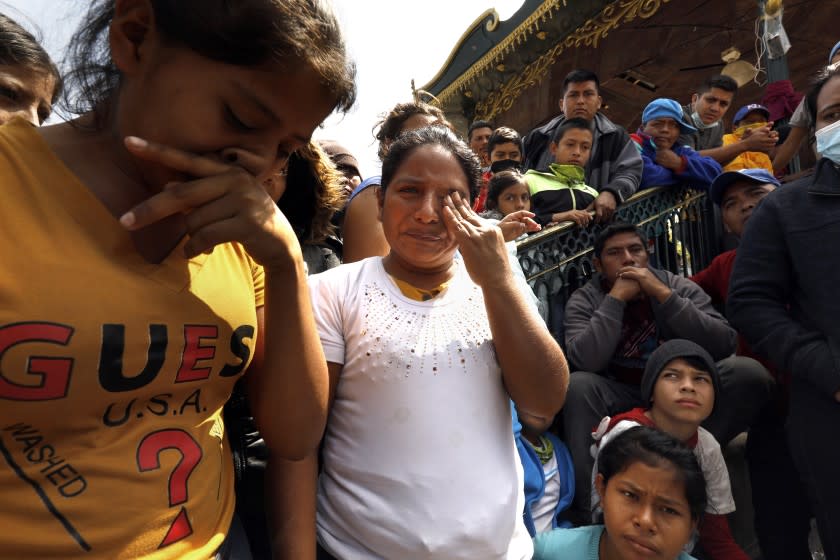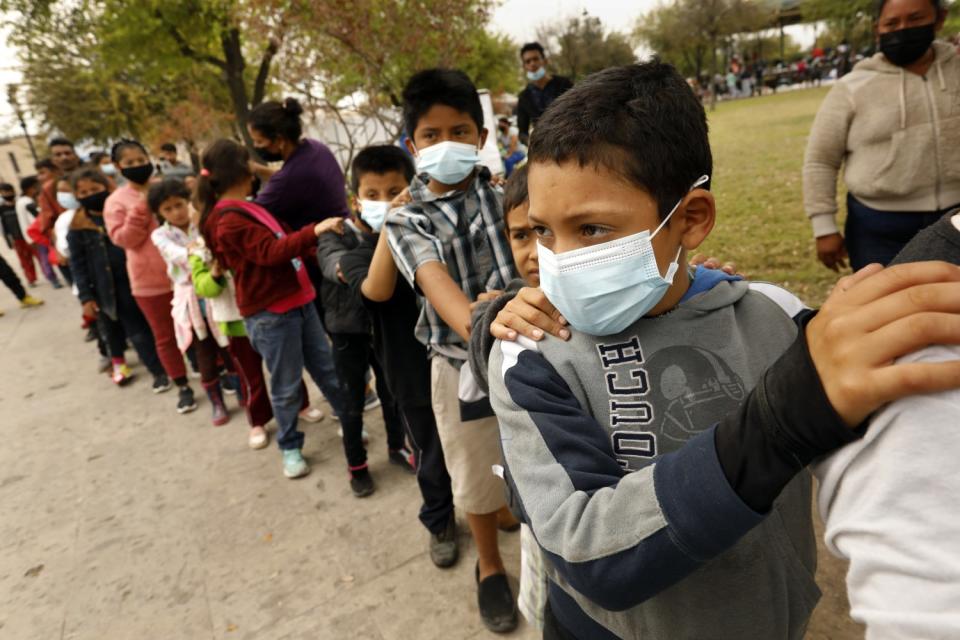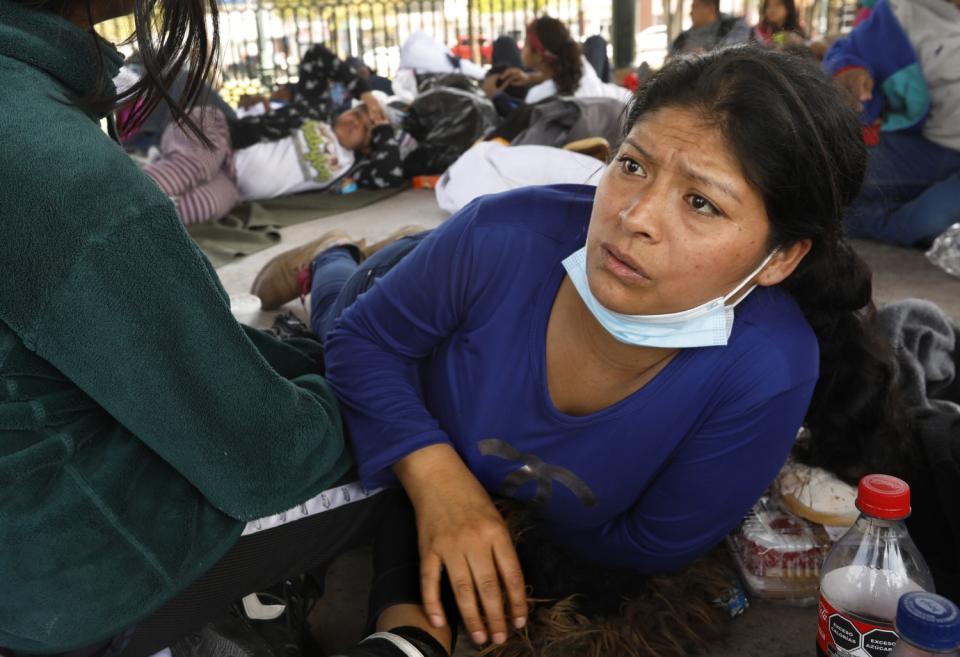U.S. border closure cracks under pressure from lawsuits, advocates and the easing pandemic

- Oops!Something went wrong.Please try again later.
When Maria stepped off the bus in late March, her 3-year-old daughter in her arms, her stomach dropped: The men waiting wore Mexican uniforms. U.S. officials had sent the Honduran mother and toddler to Tijuana.
Days earlier, Maria had crossed the border some 1,500 miles away, near Hidalgo, Texas, to seek out the Border Patrol and ask for asylum. The agents told her she was being sent to another state to make her claim, she told the Los Angeles Times.
Instead, they put her on a plane to California and expelled her and her daughter to Mexico under a Trump-era pandemic policy known as Title 42, issued by the Centers for Disease Control and Prevention, which indefinitely closed U.S. borders to "nonessential" travel.
President Biden has criticized his predecessor's immigration policies as cruel. Yet amid a record-topping increase in migration, his administration has kept Title 42 in place.

Since Biden took office in January, U.S. border officials have carried out roughly 350,000 expulsions, with nearly 50,000 families among those expelled, according to a Times analysis of the latest government data. Many were flown hundreds of miles laterally from where they crossed the border, sent in the dark with little warning to some of the most dangerous cities in northern Mexico.
Now, after months of pressure from advocates and a lawsuit brought by the American Civil Liberties Union challenging the use of Title 42 against families, as well as an easing pandemic and indications of a leveling-off in border crossings, Biden administration officials have quietly agreed to changes that are narrow yet substantial. They include an end to the lateral expulsion flights and late-night expulsions, which both exacerbate migrants' vulnerability.
Administration officials have issued new guidance to stop flights from the Rio Grande Valley in Texas that have been used to transfer and expel migrants to Mexico from El Paso and San Ysidro, Calif., and for agents to abide by existing binational agreements about where and when border removals can occur, said Lee Gelernt of the ACLU. Typically, the agreements dictate that migrants be handed off directly from U.S. officials to their Mexican counterparts, during daylight hours and at designated ports of entry.
“I was only told that I was going to another state, where I was going to apply for asylum, and they didn’t tell me any more than that,” Maria said of her removal. “This is traumatic that they do this to us.”
The administration also has agreed to allow several hundred vulnerable migrants — identified by the ACLU, other advocates and a consortium of nongovernmental organizations — into the United States per day under humanitarian parole. Since March, under the ACLU process alone, about 2,000 family members have been permitted to enter, Gelernt told The Times.

For months, the ACLU has essentially put on hold its lawsuit against Title 42 while it negotiates with the Biden administration over plans to ultimately end the policy; on Thursday, the group agreed to another short extension. The administration announced in early February that it would no longer expel unaccompanied minors and would review Title 42, but officials have refused to give a timeline or metrics for when the policy will be lifted, said Gelernt, who sued the Trump administration over the policy.
“We have made the decision that we need to save lives while we’re negotiating, even if it potentially gives the government some cover in keeping Title 42,” Gelernt told The Times. "Litigation is never a certain bet, and the government could revoke concessions it has made.”
Neither the lead Justice Department lawyer on the Title 42 lawsuit nor the Homeland Security Department provided comment. But publicly and privately, administration officials acknowledge that their position is unsustainable.
“The use of Title 42 is not a source of pleasure, but rather frankly, a source of pain,” Homeland Security Secretary Alejandro N. Mayorkas said recently at UCLA. “There is no intention to use the CDC’s Title 42 authority a day longer than the public health imperative requires.”
Still, administration officials have resisted barring expulsions altogether at the border's most dangerous spots, such as Tamaulipas, across from Texas’ Rio Grande Valley. And while top officials have agreed to stop lateral flights, there's no deal on pausing expulsions via bus transfers, which risk spreading COVID-19 in the U.S. and Mexico and continue to endanger asylum seekers.

Individuals "may be transported via air or ground transportation to other sectors along the Southwest border," U.S. Customs and Border Protection spokesman Justin Long told The Times in a statement, saying such decisions are made based on each area's capacity, "not by external influences."
Since March, there have been at least 117 expulsion flights from Brownsville, Texas, and Yuma, Ariz., to El Paso and San Diego, removing thousands of asylum-seeking families, said Tom Cartwright of Witness at the Border, who monitors the flights. More than 350 migrants a day are moved by bus and expelled in the stretch of Texas across from Tamaulipas alone, he said, but bus transfers are “virtually impossible” to track.
Biden administration officials acknowledge that part of their calculation in acceding to narrow changes while keeping the broader Title 42 policy in place is not just to try to keep numbers down at the border now, but also to buy time to find an alternative for when the public health order is lifted — either by choice or by force.
The officials have been urging Mexico to take more expelled single adults and families, but Mexican authorities are citing limited capacity due to a new Mexican law prohibiting the detention of migrant children. The Biden administration also faces a separate lawsuit in Texas from a group founded by anti-immigration Trump advisor Stephen Miller; the suit argues that not expelling everyone is a violation of the policy.
Meanwhile, the United States is reopening.
“It’s becoming increasingly difficult for them to justify keeping Title 42, in light of the entire country opening up and the rate people are being vaccinated,” Gelernt said.
Several federal judges have determined that the Title 42 policy is probably unlawful. Yet Biden officials and the policy's critics are keenly aware of the political climate — and the current conservative leaning of the Supreme Court, said Sue Kenney-Pfalzer, Border and Asylum Network director at HIAS, a nonprofit refugee advocacy group.
When Title 42 is lifted, “there will be a lot of people wanting to cross,” she said. “They are afraid of the 'bad publicity' from Republicans saying, ‘Biden opened the border.’”
Sen. Josh Hawley (R-Mo.) pressed Mayorkas over stopping lateral flights during a hearing Thursday on Capitol Hill, suggesting it was "due to the pressure of left-wing groups.”
“We make our decisions ... in furtherance of our mission, and not due to pressure by outside groups,” Mayorkas said.
Meanwhile, advocates who have called on the Biden administration to end Title 42 are also working with officials to identify and process vulnerable migrants who have been subjected to it, potentially prolonging the policy.
Raymundo Tamayo, Mexico director for the International Rescue Committee, one of the main organizations behind the effort, said it has told the administration that the work will be “time-bound” — three months — and not an “alternative mechanism” that allows Title 42 to remain.
The closed-door negotiations and the Biden administration's reticence to be seen as conciliatory are adding confusion for thousands in limbo at the border, said Margaret Cargioli, managing attorney at the Immigrant Defenders Law Center.
“There hasn’t been an announcement of any policy change," she said. "Does that mean the flights won’t resume?”
As for Maria, who fears for her safety and asked that only her first name be used, she remains in hiding with her daughter in Tijuana. In 2019, after a previous border crossing, the pair were sent from Texas to California and then to Tijuana under then-President Trump's "Remain in Mexico" policy. They missed a court hearing for asylum, however, because they were kidnapped — an account backed by legal documents obtained by The Times.
After they were sent from Texas to Tijuana for the second time under Title 42, a lawyer with Human Rights First requested that Customs and Border Protection grant them humanitarian parole to pursue asylum in the United States.
After publication, the federal agency responded and granted the request, the lawyer, Robyn Barnard, told The Times. Maria and her daughter will be allowed to enter the United States at the end of May and apply for asylum, almost two years after their first attempt.
This story originally appeared in Los Angeles Times.

